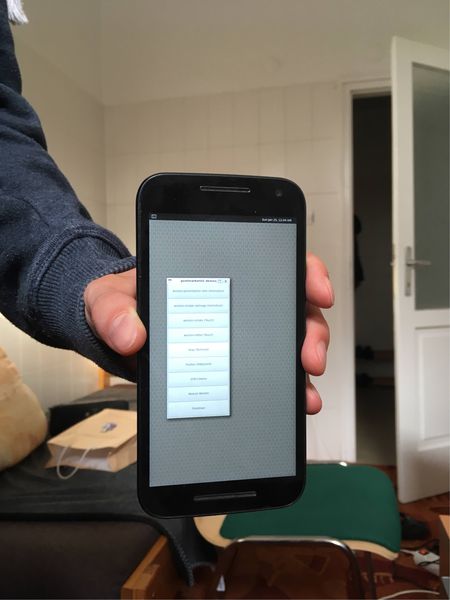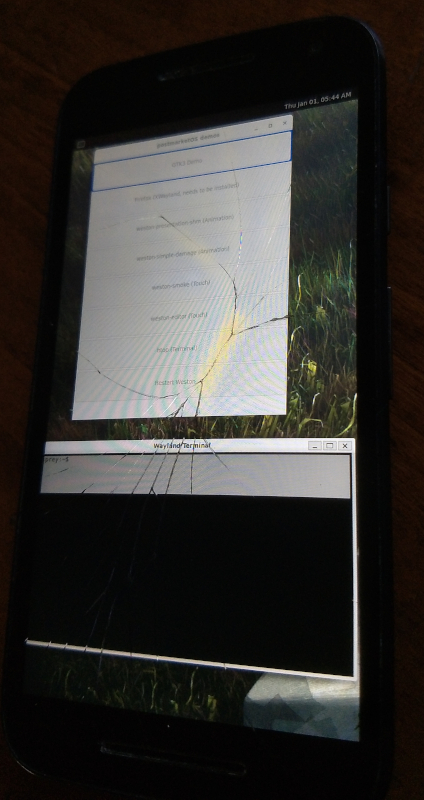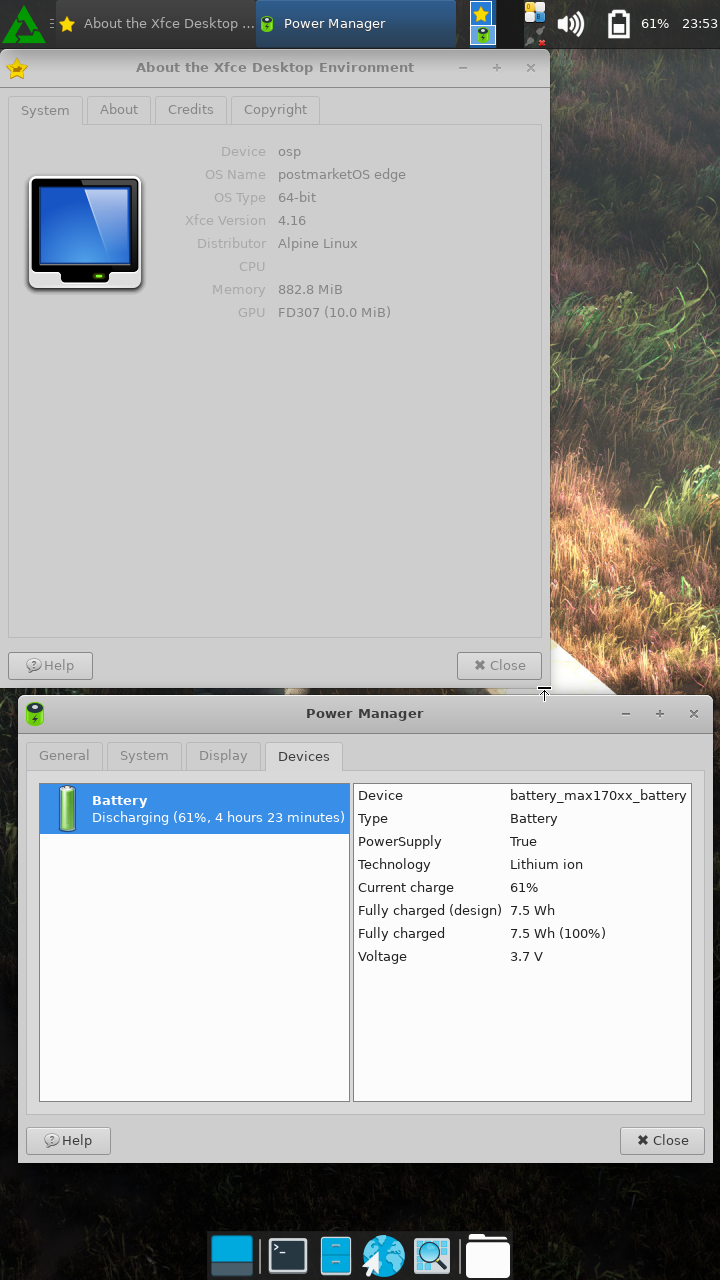Motorola Moto G 2015 (motorola-osprey): Difference between revisions
m Add type |
|||
| (43 intermediate revisions by 15 users not shown) | |||
| Line 1: | Line 1: | ||
{{Infobox device | {{Infobox device | ||
| manufacturer = Motorola | | manufacturer = Motorola | ||
| Line 8: | Line 6: | ||
| imagecaption = Moto G 2015 | | imagecaption = Moto G 2015 | ||
| releaseyear = 2015 | | releaseyear = 2015 | ||
| originalsoftware = Android 5.1.1 | | originalsoftware = Android | ||
| chipset = Qualcomm | | originalversion = 5.1.1 | ||
| chipset = Qualcomm Snapdragon 410 (MSM8916) | |||
| cpu = Quad-core 1.4 GHz Cortex-A53 | | cpu = Quad-core 1.4 GHz Cortex-A53 | ||
| gpu = Adreno 306 | | gpu = Adreno 306 | ||
| Line 15: | Line 14: | ||
| display = 720x1280 IPS | | display = 720x1280 IPS | ||
| memory = 1/2 GB | | memory = 1/2 GB | ||
| architecture = | | architecture = aarch64 | ||
| type = handset | |||
| whet_dhry = 902.7 | |||
| status_usbnet = Y | | status_usbnet = Y | ||
| status_flashing = Y | | status_flashing = Y | ||
| status_touch = Y | | status_touch = Y | ||
| status_screen = P | | status_screen = P | ||
| status_wifi = | | status_wifi = Y | ||
| status_xwayland = Y | | status_xwayland = Y | ||
| status_fde = | | status_fde = | ||
| status_mainline = | | status_mainline = Y | ||
| status_battery = | | status_battery = | ||
| status_3d = | | status_3d = Y | ||
| status_accel = | | status_accel = | ||
| status_audio = | | status_audio = Y | ||
| status_bluetooth = | | status_bluetooth = P | ||
| status_camera = | | status_camera = | ||
| status_gps = | | status_gps = Y | ||
| status_mobiledata = | | status_mobiledata = | ||
| status_sms = | | status_sms = | ||
| status_calls = | | status_calls = | ||
| booting = yes | | booting = yes | ||
}} | | genericdevice=Generic MSM8916 (qcom-msm8916) | ||
| optionalgenericdevice = yes | |||
}}{{Based on SoC|Qualcomm_Snapdragon_410/412_(MSM8916)|Snapdragon 410}} | |||
== Contributors == | == Contributors == | ||
* [[User:Ata2001|ata2001]] | * [[User:Ata2001|ata2001]] | ||
| Line 42: | Line 45: | ||
== Device owners == | == Device owners == | ||
{{Device owners}} | {{Device owners}} | ||
== How to enter flash mode == | == How to enter flash mode == | ||
Power off the device, hold down the {{Button|Power}} and the {{Button|Volume Up}} key for 1-2 seconds. Some devices you may need to hold down the {{Button|Power}} and the {{Button|Volume Down}} key instead. | Power off the device, hold down the {{Button|Power}} and the {{Button|Volume Up}} key for 1-2 seconds. Some devices you may need to hold down the {{Button|Power}} and the {{Button|Volume Down}} key instead. | ||
For unlocking the bootloader see [[Bootloader#Motorola]]. | |||
== Installation == | There is some exploit, but it caused bootloops on this particular model according to a community report: https://github.com/alephsecurity/initroot | ||
== Mainline Installation == | |||
Follow the [[Installation_guide]]. | Follow the [[Installation_guide]]. | ||
Download lk2nd from https://github.com/msm8916-mainline/lk2nd and flash it to the device. Make sure lk2nd is active before flashing postmarketos kernel. | |||
Follow [[Qualcomm_Snapdragon_410/412_(MSM8916)#Installation]]. | |||
Note: A recent (edge, alpine-release 3.19_alpha20230901) attempt to install via sideloading a recovery zip image fails ({{issue|1877}}, not specific to osprey, but rather to MSM8916). The end of pmos.log file shows: | |||
< | <pre> | ||
+ chroot /tmp/postmarketos/chroot /bin/busybox --install /bin | |||
chroot: can't execute '/bin/busybox': No such file or directory | |||
</pre> | |||
</ | |||
Similarly, an attempt to manually flash via fastboot (lk2nd 0.15.0) fails with | |||
the error message | |||
<pre>unable to mount root partition</pre> | |||
== User Interface == | |||
The following user interfaces run on the device: | |||
* | * Xfce4 | ||
* Mate | |||
* Sxmo | |||
* Phosh | |||
* | == Known Issues == | ||
* Brightness slider doesn't work | |||
* Bluetooth paring and audio works but file transfers fail | |||
* Password entry pad occasionally becomes unresponsive | |||
== Hardware details (<code>hwtest</code>) == | |||
<code> | {| class="wikitable feature-colors" | ||
! style="text-align:left;"| Category | |||
! style="text-align:left;"| Model | |||
! style="text-align:left;"| Path | |||
! style="text-align:left;"| Status | |||
! style="text-align:left;"| Value | |||
|- | |||
|framebuffer | |||
|msmdrmfb | |||
|/sys/class/graphics/fb0 | |||
| class="feature-yes"| Working | |||
|U:720x1280p-0 | |||
|- | |||
|drm | |||
| | |||
|/sys/class/drm/card0-DSI-1 | |||
| class="feature-yes"| Working | |||
|720x1280 | |||
|- | |||
|vibrator | |||
|pm8xxx_vib_ffmemless | |||
|/dev/input/event4 | |||
| class="feature-yes"| Working | |||
| | |||
|- | |||
|input | |||
|Synaptics S2726BR_T | |||
|/dev/input/event3 | |||
| class="feature-yes"| Working | |||
| | |||
|- | |||
|input | |||
|GPIO Buttons | |||
|/dev/input/event2 | |||
| class="feature-yes"| Working | |||
| | |||
|- | |||
|input | |||
|pm8941_resin | |||
|/dev/input/event1 | |||
| class="feature-yes"| Working | |||
| | |||
|- | |||
|input | |||
|pm8941_pwrkey | |||
|/dev/input/event0 | |||
| class="feature-yes"| Working | |||
| | |||
|- | |||
|input | |||
|msm8916 Headset Jack | |||
|/dev/input/event5 | |||
| class="feature-yes"| Working | |||
| | |||
|} | |||
== Photos == | == Photos == | ||
[[File:Osprey-pmos.jpg]] | [[File:Osprey-pmos.jpg]] | ||
[[File:Osprey-weston-armv7.jpg]] | |||
[[File:screenshot-osprey-xfce4-about-pwr.png]] | |||
== Links == | == Links == | ||
| Line 103: | Line 149: | ||
* [https://wiki.lineageos.org/devices/osprey/ LineageOS wiki] | * [https://wiki.lineageos.org/devices/osprey/ LineageOS wiki] | ||
* {{Device package|motorola-osprey}} | * {{Device package|motorola-osprey}} | ||
* {{ | * {{issue|1877}} Recovery zip creation will succeed, but installation will fail | ||
Latest revision as of 17:39, 12 September 2024
| This page is about the dedicated port of this device. There is also an optional generic port available for this device - see Generic MSM8916 (qcom-msm8916). |
 Moto G 2015 | |
| Manufacturer | Motorola |
|---|---|
| Name | Moto G 2015 |
| Codename | motorola-osprey |
| Released | 2015 |
| Type | handset |
| Hardware | |
| Chipset | Qualcomm Snapdragon 410 (MSM8916) |
| CPU | Quad-core 1.4 GHz Cortex-A53 |
| GPU | Adreno 306 |
| Display | 720x1280 IPS |
| Storage | 8/16 GB |
| Memory | 1/2 GB |
| Architecture | aarch64 |
| Software | |
| Original software | Android |
| Original version | 5.1.1 |
| postmarketOS | |
| Category | testing |
| Pre-built images | no |
| Mainline | yes |
| Unixbench Whet/Dhry score | 902.7 |
| Optional Generic Port | Generic MSM8916 (qcom-msm8916) |
| Flashing |
Works |
|---|---|
| USB Networking |
Works |
| Internal storage |
No data |
| SD card |
No data |
| Battery |
No data |
| Screen |
Partial |
| Touchscreen |
Works |
| Multimedia | |
| 3D Acceleration |
Works |
| Audio |
Works |
| Camera |
No data |
| Camera Flash |
No data |
| Connectivity | |
| WiFi |
Works |
| Bluetooth |
Partial |
| GPS |
Works |
| NFC |
No data |
| Modem | |
| Calls |
No data |
| SMS |
No data |
| Mobile data |
No data |
| Miscellaneous | |
| FDE |
No data |
| USB OTG |
No data |
| HDMI/DP |
No data |
| Sensors | |
| Accelerometer |
No data |
| Magnetometer |
No data |
| Ambient Light |
No data |
| Proximity |
No data |
| Hall Effect |
No data |
| Haptics |
No data |
| Barometer |
No data |
| This device is based on the Snapdragon 410. See the SoC page for common tips, guides and troubleshooting steps |
Contributors
Maintainer(s)
Device owners
- Ata2001
- Colaur (Notes: Functionnal, broken glass)
- Fennell
- Frbrr02 (Notes: Model: XT1541)
- Hpott
- MartijnBraam
- MishterKirby
- Nobodywasishere (Notes: Cracked glass and SIM doesn't work, otherwise functional)
- Tau (Notes: Slightly cracked screen, running LineageOS with MicroG 17))
- Unrznbl (Notes: 2022-09-21 testing)
How to enter flash mode
Power off the device, hold down the and the key for 1-2 seconds. Some devices you may need to hold down the and the key instead.
For unlocking the bootloader see Bootloader#Motorola.
There is some exploit, but it caused bootloops on this particular model according to a community report: https://github.com/alephsecurity/initroot
Mainline Installation
Follow the Installation_guide.
Download lk2nd from https://github.com/msm8916-mainline/lk2nd and flash it to the device. Make sure lk2nd is active before flashing postmarketos kernel.
Follow Qualcomm_Snapdragon_410/412_(MSM8916)#Installation.
Note: A recent (edge, alpine-release 3.19_alpha20230901) attempt to install via sideloading a recovery zip image fails (#1877, not specific to osprey, but rather to MSM8916). The end of pmos.log file shows:
+ chroot /tmp/postmarketos/chroot /bin/busybox --install /bin chroot: can't execute '/bin/busybox': No such file or directory
Similarly, an attempt to manually flash via fastboot (lk2nd 0.15.0) fails with the error message
unable to mount root partition
User Interface
The following user interfaces run on the device:
- Xfce4
- Mate
- Sxmo
- Phosh
Known Issues
- Brightness slider doesn't work
- Bluetooth paring and audio works but file transfers fail
- Password entry pad occasionally becomes unresponsive
Hardware details (hwtest)
| Category | Model | Path | Status | Value |
|---|---|---|---|---|
| framebuffer | msmdrmfb | /sys/class/graphics/fb0 | Working | U:720x1280p-0 |
| drm | /sys/class/drm/card0-DSI-1 | Working | 720x1280 | |
| vibrator | pm8xxx_vib_ffmemless | /dev/input/event4 | Working | |
| input | Synaptics S2726BR_T | /dev/input/event3 | Working | |
| input | GPIO Buttons | /dev/input/event2 | Working | |
| input | pm8941_resin | /dev/input/event1 | Working | |
| input | pm8941_pwrkey | /dev/input/event0 | Working | |
| input | msm8916 Headset Jack | /dev/input/event5 | Working |
Photos
Links
- pmbootstrap!714 Initial merge request
- LineageOS wiki
- Device package
- #1877 Recovery zip creation will succeed, but installation will fail


